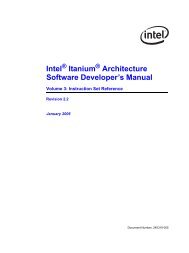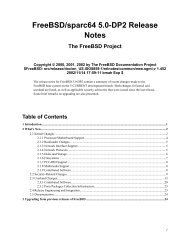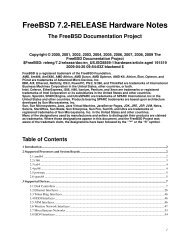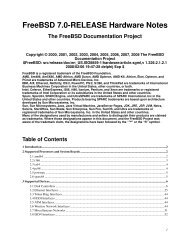Suleiman Souhlal 904-344-811 Math 4175 Project 1 In this report ...
Suleiman Souhlal 904-344-811 Math 4175 Project 1 In this report ...
Suleiman Souhlal 904-344-811 Math 4175 Project 1 In this report ...
You also want an ePaper? Increase the reach of your titles
YUMPU automatically turns print PDFs into web optimized ePapers that Google loves.
<strong>Suleiman</strong> <strong>Souhlal</strong> <strong>904</strong>-<strong>344</strong>-<strong>811</strong> <strong>Math</strong> <strong>4175</strong> <strong>Project</strong> 1<br />
<strong>In</strong> <strong>this</strong> <strong>report</strong>, we will see a toy implementation of the AES cipher in the Haskell<br />
programming language. This implementation differs from the normal AES in that it<br />
uses a smaller square grid of 3 × 3, instead of 4 × 4, a smaller field of GF (2 4 ) instead<br />
of GF (2 8 ), and has fewer rounds (5 instead of 10). The sources we have used are the<br />
textbook, the notes from class and the original AES proposal. We will thoroughly<br />
comment the code, describing design considerations.<br />
First, we import the modules that are needed:<br />
import List<br />
import Array<br />
import Bits<br />
import <strong>In</strong>t<br />
Since we use a different field than the original AES, we also need a different irreductible<br />
polynomial, to build it. The polynomial chosen is x 4 + x + 1. Note that the<br />
polynomial, and the elements of GF (2 4 ) are represented by lists of booleans, where<br />
the least significant bit is the rightmost element of the list.<br />
irreduct = [True, False, False, True, True]<br />
Since we use lists of booleans to represent the elements of the field, we also need<br />
functions that convert 4 bit integers into these lists, and vice versa.<br />
numToList n = reverse $ map (testBit (n::<strong>In</strong>t8)) [0..3]<br />
listToNum :: [Bool] -> <strong>In</strong>t<br />
listToNum l =<br />
foldr (\x y -> setBit y x) 0<br />
$ fst (unzip $ (filter (\x -> snd x == True) $ reverse $<br />
zip [0..] $ reverse l))<br />
Addition of two elements in GF (2 4 ) can be modelled as the exclusive or of the<br />
two bit strings representing the elements. Since <strong>this</strong> is the central operation of the<br />
cryptosystem, we declare a function that performs the exclusive or of two bit strings.<br />
xorBits :: [Bool] -> [Bool] -> [Bool]<br />
xorBits x y = reverse $ map (\x -> xor (fst x) (snd x)) $ zip (reverse x)<br />
(reverse y)<br />
where<br />
xor x y = (x || y) && ((not x) || (not y))<br />
We also need a function that makes sure that a bit string is exactly 4 bits long.<br />
make4 x<br />
| length x < 4 = (take (4 - length x) (repeat False)) ++ x<br />
| length x >= 4 = x
<strong>Suleiman</strong> <strong>Souhlal</strong> <strong>904</strong>-<strong>344</strong>-<strong>811</strong> <strong>Math</strong> <strong>4175</strong> <strong>Project</strong> 2<br />
Now that the utility functions have been written, we can start implementing the<br />
different layers of the cryptosystem.<br />
The first layer of AES is byteSub. This is a non-linear operation on a block of data,<br />
where each element in the block gets transformed to another byte, according to an<br />
S-box. This S-box is generated in the following way:<br />
We start with a byte x3x2x1x0, where each xi is a binary bit. We then compute its<br />
inverse in GF (2 4 ), to obtain another byte, y3y2y1y0. Note that 0000 does not have<br />
an inverse, so we must use 0000. We then do the following operation, to find the<br />
transformed value z3z2z1z0.<br />
⎛<br />
1<br />
⎜ 1<br />
⎜<br />
⎝ 1<br />
0<br />
1<br />
1<br />
1<br />
0<br />
1<br />
⎞ ⎛ ⎞<br />
1 y0<br />
1 ⎟ ⎜ ⎟<br />
⎟ ⎜ y1 ⎟<br />
⎟ ⎜ ⎟<br />
0 ⎠ ⎝ y2 ⎠<br />
0 1 1 1 y3<br />
+<br />
⎛ ⎞<br />
1<br />
⎜ 0 ⎟<br />
⎜ ⎟<br />
⎝ 1 ⎠<br />
0<br />
=<br />
⎛ ⎞<br />
z0<br />
⎜ ⎟<br />
⎜ z1 ⎟<br />
⎜ ⎟<br />
⎝ z2 ⎠<br />
z3<br />
Since doing all <strong>this</strong> at run time would be quite expensive, we have pre-calculated<br />
the transformed value for every possible input. The results have been arranged in a<br />
table, for fast look-up: The first two bits of a number gives the row in the table, and<br />
the last two bits give the column.<br />
The resulting table is:<br />
⎡<br />
⎢<br />
sBox = ⎢<br />
⎣<br />
5 2 11 12<br />
8 15 6 1<br />
14 9 0 7<br />
3 4 13 10<br />
sBox :: Array (<strong>In</strong>t, <strong>In</strong>t) <strong>In</strong>t8<br />
sBox = listArray ((0,0), (3,3)) [5, 2, 11, 12, 8, 15, 6, 1, 14, 9,<br />
0, 7, 3 ,4, 13, 10]<br />
Since we also need to be able to decrypt, we have an inverse table:<br />
⎡<br />
⎢<br />
invSBox = ⎢<br />
⎣<br />
⎤<br />
⎥<br />
⎦<br />
10 7 1 12<br />
13 0 6 11<br />
4 9 15 2<br />
3 14 8 5<br />
invSBox :: Array (<strong>In</strong>t, <strong>In</strong>t) <strong>In</strong>t8<br />
invSBox = listArray ((0,0), (3,3)) [10, 7, 1, 12, 13, 0, 6, 11, 4, 9, 15, 2,<br />
3, 14, 8, 5]<br />
The byteSub function simply selects the transformed value from the input bit<br />
string, and table to use.<br />
⎤<br />
⎥<br />
⎦
<strong>Suleiman</strong> <strong>Souhlal</strong> <strong>904</strong>-<strong>344</strong>-<strong>811</strong> <strong>Math</strong> <strong>4175</strong> <strong>Project</strong> 3<br />
byteSub sbox l =<br />
map (byteSub’ sbox) l<br />
where<br />
byteSub’ sbox l = numToList (sbox ! (row l, col l))<br />
row l = listToNum $ take 2 l<br />
col l = listToNum $ drop 2 l<br />
The next layer of the AES cryptosystem is shiftRow. <strong>In</strong> <strong>this</strong> layer, all that is done<br />
is shifting the rows of the matrix cyclically by 0, 1 and 2.<br />
⎛<br />
⎞ ⎛<br />
⎞<br />
⎜<br />
⎝<br />
c0,0 c0,1 c0,2<br />
c1,0 c1,1 c1,2<br />
c2,0 c2,1 c2,2<br />
⎟ ⎜<br />
⎠ = ⎝<br />
b0,0 b0,1 b0,2<br />
b1,0 b1,1 b1,2<br />
b2,0 b2,1 b2,2<br />
The inverse operation, invShiftRow is the same, except shifting right.<br />
rotateLeft n l = let split = splitAt n l in<br />
(snd split) ++ (fst split)<br />
rotateRight n l = rotateLeft (length l - n) l<br />
shiftRow b = shiftRow’ rotateLeft b<br />
invShiftRow b = shiftRow’ rotateRight b<br />
shiftRow’ f b =<br />
let split = splitAt 3 b in<br />
shiftRow’’ f 0 (fst split) (snd split)<br />
where<br />
shiftRow’’ f n l [] = f n l<br />
shiftRow’’ f n l rest = let split’ = splitAt 3 rest in<br />
(f n l) ++ (shiftRow’’ f (n + 1) (fst split’)<br />
(snd split’))<br />
The next layer of AES is mixColumns. <strong>In</strong> <strong>this</strong> layer, we multiply the block of data<br />
in GF (24 ) by another matrix:<br />
⎛<br />
1<br />
⎜<br />
⎝ 1<br />
2<br />
1<br />
⎞ ⎛<br />
1 c0,0<br />
⎟ ⎜<br />
2 ⎠ ⎝ c1,0<br />
c0,1<br />
c1,1<br />
c0,2<br />
c1,2<br />
⎞ ⎛<br />
d0,0<br />
⎟ ⎜<br />
⎠ = ⎝ d1,0<br />
d0,1<br />
d1,1<br />
d0,2<br />
d1,2<br />
⎞<br />
⎟<br />
⎠<br />
2 1 1<br />
This matrix was chosen because:<br />
c2,0 c2,1 c2,2<br />
⎟<br />
⎠<br />
d2,0 d2,1 d2,2<br />
• It has to be invertible, since we need to be able to decrypt.<br />
• If one input byte changes, 3 bytes change in in the output, since if we expand<br />
the operation, we see that<br />
⎛<br />
⎞ ⎛<br />
⎞<br />
⎜<br />
⎝<br />
d0,0 d0,1 d0,2<br />
d1,0 d1,1 d1,2<br />
d2,0 d2,1 d2,2<br />
⎟ ⎜<br />
⎠ = ⎝<br />
c0,0 + 2c1,0 + c2,0 c0,1 + 2c1,1 + c2,1 c0,2 + 2c1,2 + c2,2<br />
c0,0 + c1,0 + 2c2,0 c0,1 + c1,1 + 2c2,1 c0,2 + c1,2 + 2c2,2<br />
2c0,0 + c1,0 + c2,0 2c0,1 + c1,1 + c2,1 2c0,2 + c1,2 + c2,2<br />
⎟<br />
⎠
<strong>Suleiman</strong> <strong>Souhlal</strong> <strong>904</strong>-<strong>344</strong>-<strong>811</strong> <strong>Math</strong> <strong>4175</strong> <strong>Project</strong> 4<br />
mixColumns c =<br />
elems $ matMult mixMat cmat<br />
where<br />
mixMat = listArray ((1,1),(3,3)) (map numToList [1,2,1,1,1,2,2,1,1])<br />
cmat = listArray ((1,1), (3,3)) $ map make4 c<br />
invMixColumns c =<br />
elems $ matMult invMixMat cmat<br />
where<br />
invMixMat = listArray ((1,1), (3,3)) (map numToList [7,7,9,9,7,7,7,9,7])<br />
cmat = listArray ((1,1), (3,3)) $ map make4 c<br />
The code that performs multiplication in GF (2 4 ) follows.<br />
gMult x y =<br />
let s = dropWhile (not . ((==) True)) y in -- Remove leading 0s<br />
case s of<br />
[] -> [False, False, False, False]<br />
[True] -> x<br />
otherwise -> xorBits (make4 $ mult (length s - 1) x)<br />
(make4 $ gMult x $ tail s)<br />
where<br />
To multiply a number by x n , we simply shift it to the left n times. If the result is<br />
greater or equal to x 4 , we obtain the (mod x 4 +x+1), by XORing it with the irreductible<br />
polynomial.<br />
mult 0 x = x<br />
mult n x =<br />
let shifted = dropWhile (not . ((==) True)) $ shiftLeft 1 x in<br />
if (length shifted > 4) && (head shifted == True)<br />
then make4 $ mult (n-1) $ xorBits shifted irreduct<br />
else make4 $ mult (n-1) shifted<br />
where<br />
shiftLeft n l = l ++ (take n $ repeat False)<br />
This is to perform matrix multiplication.<br />
matMult x y = array ((1,1), (3,3))<br />
[((i, j), xorSum [gMult (x ! (i, k)) (y ! (k, j))<br />
| k
<strong>Suleiman</strong> <strong>Souhlal</strong> <strong>904</strong>-<strong>344</strong>-<strong>811</strong> <strong>Math</strong> <strong>4175</strong> <strong>Project</strong> 5<br />
The last layer of AES is roundKey. <strong>In</strong> <strong>this</strong> round we simply XOR the block by the<br />
round key, which we’ll discuss later.<br />
⎛<br />
⎜<br />
⎝<br />
d0,0 d0,1 d0,2<br />
d1,0 d1,1 d1,2<br />
d2,0 d2,1 d2,2<br />
⎞ ⎛<br />
⎟ � ⎜<br />
⎠ ⎝<br />
k0,0 k0,1 k0,2<br />
k1,0 k1,1 k1,2<br />
k2,0 k2,1 k2,2<br />
⎞<br />
⎛<br />
⎟ ⎜<br />
⎠ = ⎝<br />
e0,0 e0,1 e0,2<br />
e1,0 e1,1 e1,2<br />
e2,0 e2,1 e2,2<br />
roundKey :: <strong>In</strong>t -> [[Bool]] -> [[Bool]] -> [[Bool]]<br />
roundKey i k d = roundKey’ d $ keyMat i k<br />
where<br />
keyMat i k = concat $ transpose $ [keySchedule (3*i) k] ++<br />
[keySchedule (3*i + 1) k] ++ [keySchedule (3*i + 2) k]<br />
roundKey’ d k = map (\x -> xorBits (fst x) (snd x)) $ zip d k<br />
The original key consists of 4 ∗ 3 ∗ 3 = 36 bits. The key is arranged in a 3 × 3<br />
matrix. This matrix is then expanded by adding 15 additional columns. We label each<br />
column W (i). Then, if i is not a multiple of 3,<br />
If i is a multiple of 3,<br />
W (i) = W (i − 3) ⊕ W (i − 1)<br />
W (i) = W (i − 3) ⊕ T (W (i − 1))<br />
where T (x) is the transformation of x obtained as follows:<br />
Let the elements of x be a, b, c. We then rotate them, to obtain b, c, a. Then, we replace<br />
each of these bytes with the corresponding element in the S-box from byteSub, to get<br />
3 bytes e, f, g. Then, T (x) is the column vector<br />
(e ⊕ 0010 (i−3)/3 , f, g)<br />
The round key for the ith round is then the columns<br />
W (3i), W (3i + 1), W (3i + 2)<br />
keySchedule :: <strong>In</strong>t -> [[Bool]] -> [[Bool]]<br />
keySchedule i l =<br />
if i < 3<br />
then take 3 $ drop (3*i) l<br />
else<br />
if mod i 3 == 0<br />
then map (\x -> xorBits (fst x) (snd x)) $<br />
zip (keySchedule (i-3) l) (trans i (keySchedule (i-1) l))<br />
else map (\x -> xorBits (fst x) (snd x)) $<br />
zip (keySchedule (i-3) l) (keySchedule (i-1) l)<br />
where<br />
trans i l’ = [xorBits (head (sbox l’)) (roundConst i)] ++ (tail (sbox l’))<br />
⎞<br />
⎟<br />
⎠
<strong>Suleiman</strong> <strong>Souhlal</strong> <strong>904</strong>-<strong>344</strong>-<strong>811</strong> <strong>Math</strong> <strong>4175</strong> <strong>Project</strong> 6<br />
sbox l’’ = byteSub sBox $ rotateLeft 1 l’’<br />
roundConst 0 = [False, False, False, True]<br />
roundConst i = foldr (\x y -> x y) [True] $ take (1 + div (i - 3) 3) $<br />
repeat (gMult [False, False, True, False])<br />
Now that we have seen what each layer of AES consists of, we can see how they<br />
are arranged to form a round.<br />
Each round is made of byteSub, shiftRow, mixColumn, roundKey, applied in <strong>this</strong><br />
order.<br />
The last round does not have mixColumn.<br />
aesRound i k a = roundKey i k $ mixColumns $ shiftRow $ byteSub sBox a<br />
lastRound i k a = roundKey i k $ shiftRow $ byteSub sBox a<br />
Therefore, to encrypt a block of data, we apply roundKey, with the 0th round<br />
key. Then we do 4 rounds, and finally, we do the last round. The resulting block is<br />
encrypted with the supplied key.<br />
encrypt k a = map listToNum $ lastRound 5 k’ $ aesRound 4 k’ $ aesRound 3 k’ $<br />
aesRound 2 k’ $ aesRound 1 k’ $ roundKey 0 k’ a’<br />
where<br />
k’ = map numToList k<br />
a’ = map numToList a<br />
To decrypt one round, we simply apply invMixColumns, roundKey with the ith<br />
key, invShiftRow, invByteSub The last round of the decryption does not involve<br />
invMixColumns<br />
invAesRound i k a = invMixColumns $ roundKey i k $ invShiftRow $<br />
byteSub invSBox a<br />
last<strong>In</strong>vRound i k a = roundKey i k $ invShiftRow $ byteSub invSBox a<br />
Therefore, to decrypt a block of encrypted data, we apply roundKey with the 5th<br />
round key, then do 4 rounds, and finally, we do the last round. The resulting block<br />
has been decrypted.<br />
decrypt k a = map listToNum $ last<strong>In</strong>vRound 0 k’ $ invAesRound 1 k’<br />
$ invAesRound 2 k’ $ invAesRound 3 k’ $ invAesRound 4 k’<br />
$ roundKey 5 k’ a’<br />
where<br />
k’ = map numToList k<br />
a’ = map numToList a<br />
An example encryption would be to encrypt<br />
P =<br />
⎡<br />
⎢<br />
⎣<br />
1 2 3<br />
4 5 6<br />
7 8 9<br />
⎤<br />
⎥<br />
⎦
<strong>Suleiman</strong> <strong>Souhlal</strong> <strong>904</strong>-<strong>344</strong>-<strong>811</strong> <strong>Math</strong> <strong>4175</strong> <strong>Project</strong> 7<br />
with the key<br />
The result should be<br />
K =<br />
E =<br />
⎡<br />
⎢<br />
⎣<br />
⎡<br />
⎢<br />
⎣<br />
9 8 7<br />
6 5 4<br />
3 2 1<br />
⎤<br />
⎥<br />
⎦<br />
14 5 13<br />
8 14 14<br />
6 9 10<br />
When decrypting, the result should be the starting value.<br />
The following snippet is the program, encrypting A with the key K, and then<br />
decrypting the result, obtaining A again.<br />
encrypt [9,8,7,6,5,4,3,2,1] [1,2,3,4,5,6,7,8,9]<br />
>>> [14,5,13,8,14,14,6,9,10]<br />
decrypt [9,8,7,6,5,4,3,2,1] [14,5,13,8,14,14,6,9,10]<br />
>>> [1,2,3,4,5,6,7,8,9]<br />
We have seen the implementation in the Haskell programming language and design<br />
decision of <strong>this</strong> AES variant, that has a different field, square grid, and number of<br />
round than the original AES.<br />
⎤<br />
⎥<br />
⎦




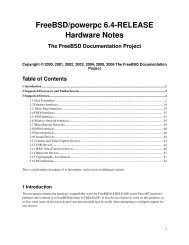

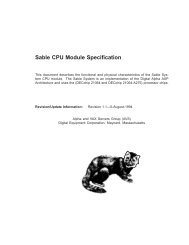
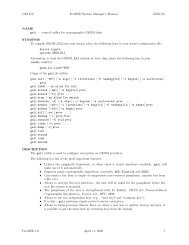
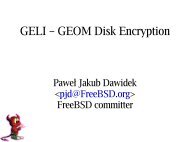
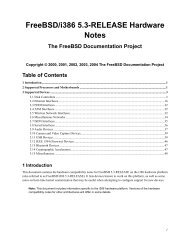


![Volume 3: Instruction Set Reference [pdf]](https://img.yumpu.com/5683779/1/190x252/volume-3-instruction-set-reference-pdf.jpg?quality=85)
